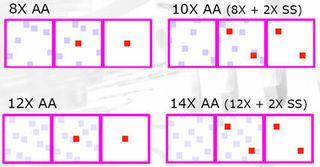ATI Puts NVIDIA's SLI in the CrossFire
Alternate Frame Rendering

Alternate Frame Rendering , also known as AFR , is the fastest dual mode. One card calculates all odd frames, the other the even frames. The principle is easily understood if you consider that a moving scene always consists of a sequence of individual images, which are strung quickly together to enable fluid movement of the displayed screen for the human eye.
Pro: Both cards divvy up the computing load optimally. This means that AFR also delivers full geometry acceleration.
Con: Does not work in games using render-to-texture functions.
SuperAA Mode

The fourth CrossFire mode is called SuperAA . In this mode the cards do not give higher frame rates, but enhanced image quality. Both calculate the same frame but with different FSAA patterns. The combiner chip then combines both images into one. This offers the user 8x anti-aliasing at 4x FSAA speed. SuperAA also enhances the quality of shader calculations. Unattractive step effects often occur when using various bump-mapping methods. But by combining the two images, these surfaces are also smoothed. Note for enthusiasts: ATI has announced that the FSAA patterns on Radeon X8xx cards are freely programmable. The CrossFire models thus do not use differing FSAA patterns to those of the standard Radeon cards.
Pro: Doubling of the FSAA factor without speed loss (compared to a single card). A maximum 12x AA or 14x AA (12x + 2xS) is possible.
Con: No increase in frame rate.

The FSAA patterns in the CrossFire SuperAA modes.
Stay on the Cutting Edge
Join the experts who read Tom's Hardware for the inside track on enthusiast PC tech news — and have for over 25 years. We'll send breaking news and in-depth reviews of CPUs, GPUs, AI, maker hardware and more straight to your inbox.
Current page: Alternate Frame Rendering
Prev Page Operating Modes: The Four Rendering Modes Next Page Radeon Xpress 200: Chipsets For AMD And IntelMost Popular

